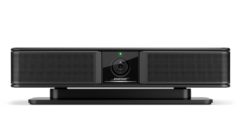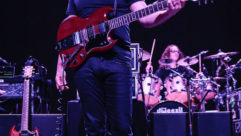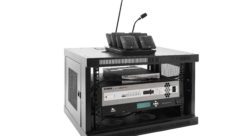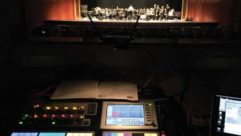Understanding the Volume Unit
Dec 1, 2002 12:00 PM,
Alvin Sydnor
Every professionally designed audio system must be based on established industry specifications and standards. System parameters cover everything from acoustics down to balancing the speakers throughout the system.
The measurements of audio power and program levels are important to the audio engineer. During the early years of radio broadcasting, there were no established standards on audio metering or monitoring audio levels. In the late ’30s, the design and development of a new audio volume indicating meter was undertaken by Bell Laboratories, Columbia Broadcasting System, and the National Broadcasting Company. The result of this research effort was the introduction of not only a new type of volume indicator meter but also a new standard reference level of 1 mW, which was adopted by the electronic industry as a standard in May 1939. The new meter became known as the volume unit (VU) meter.
The VU meter states the level of complex, nonrecurrent, and nonperiodic signals such as music and speech. The VU meter should not be used for steady-state waves, and the decibel meter should not be used for complex waves. The VU and the decibel meters are very different units and must be treated as such.
It’s not easy to characterize the time-varying waveform associated with a speech signal. The audio frequencies making up the basic speech signal are amplitude modulated several times per second at a syllable rate. In addition, the speaker’s pauses between phrases and sentences result in the speech energy being concentrated in talk spurts of about one second separated by gaps of a second or two. Thus, it’s difficult to evaluate or measure a speech signal.
In spite of these problems, the magnitude of a speech signal must be measured and characterized in some fashion, which is useful in designing and operating audio systems. Thus, the VU meter was born.
REFERENCE LEVELS
The VU meter is calibrated in volume units that are numerically equal to the number of decibels above the reference level of 1 mW of power looking into a 600Ω circuit. Along with this new meter came a new term, zero dbm, which applies only to the 1 mW reference level. The decibel scale expresses levels that are referenced to the 6 mW reference level.
Using the 1 mW reference level has three distinct advantages. It is a unit quantity and is readily applicable to the decimal system. It is also related to the watt by the factor 10, which results in positive values for the majority of measurements. All VU meters are exactly alike in construction and characteristics, and when several are connected across the same circuit, each can be treated by the application of a 1,000 cycle signal for checking their operations.
CHARACTERISTICS
Before the VU meter’s introduction, much thought and consideration were given to its necessary characteristics as being suitable for all audio applications. The following were among the VU meter’s design considerations.
General
A volume indicator uses a DC meter movement with a noncorrective full-wave rectifier unit and responds approximately to the RMS value of the impressed voltage. That will vary somewhat depending on the waveforms and the percent of harmonics present in the signal.
Scale of the instrument
The face of the instrument can have either of the two scales — or both — as shown in Fig. 1. The top scale is the standard expressing VU, and the bottom scale stresses modulation. Both have two scales. The VU scale ranges from -20 to +3 VU, and the other scale ranges from 0 to 100 with the 100 point coinciding with the 0 point on the VU scale. The normal point for reading volume levels is at 0 VU, or the 100 scale point, which is located to the right of the center at about 71 percent of the full-scale arc.
Dynamic characteristics
When the meter is connected across an external 600Ω load, a sudden application of a sine-wave voltage should give a steady-state deflection at the 0 VU or the 100 point. The pointer should overshoot not less than 1 percent and not more than 1.5 percent, which represents about 0.15 dB. The meter should be capable of reaching 99 on the percent voltage scale in 0.3 seconds.
Response versus frequency
The instrument’s sensitivity should not depart from that at 1,000 Hz by more than 0.2 dB between 35 and 10 kHz and not more than 0.5 dB between 25 and 16 kHz.
Sensitivity
Applying a sinusoidal potential of 1.228V (4 dB above 1 mW into a 600Ω load) to the instrument in series with the proper external resistance (3,600Ω) will cause a deflection to the 0 VU or the 100 percent point.
Impedance
When bridging across a line, the volume indicator, including the proper series resistance (3,600Ω), should have an impedance of 7,500Ω when measured with a sinusoidal voltage sufficient to deflect the meter to the 0 VU or the 100 percent point.
Harmonic distortion
The harmonic distortion introduced in a 600Ω circuit when a volume indicator is bridged across it should be less than 0.3 percent under the worst possible condition (in which there is no loss in the variable attenuator).
Overload
The instrument must be capable of withstanding, without damage or an effect on its calibration, peaks of ten times the voltage equivalent to a reading of 0 VU or 100 percent for 0.5 seconds and a continuous overload of five times that voltage. Unless a meter has that dynamic behavior, it cannot be used to determine volume in VUs. All electronic firms have standardized on one set of impedances and parameters when dealing with audio measurements.
Which scale to select depends on its application. For example, for broadcasting and recording purposes, it’s important to know the percentage of modulation, so the B scale will be used. When performing general testing in the field, the A scale will be used, because VU readings are more useful to the audio engineer than percentage of modulation.
Fig. 2 shows a complete VU meter schematic. The meter movement is a 50 microampere DC D’Arsonval movement with a full-wave bridge rectifier built within its case. The meter impedance, including the bridge rectifier, is 3,900. Shown there is a 3,900Ω variable attenuator and a 3,600Ω series resistor connected ahead of the meter. Whenever devices are to be bridged across circuits of 600Ω, you should have at least ten times the impedance of the circuit being bridged. By connecting the 3,600Ω resistor ahead of the attenuator, you provide bridging impedance of 7,500Ω.
Attenuators designed to be used with VU meters come with dial calibrations starting at +4 dBm and continuing in steps of 2 dB up to +44 dBm. No 0 dBm position is provided because by placing a 3,600Ω resistor ahead of the attenuator, it raises the input impedance, and a loss of 4 dB is incurred.
When the 3,900Ω meter movement and the attenuator are set at +4 dBm and placed across a 600Ω circuit in which 1 mW of power is flowing, the pointer will be deflected to the 100 percent or 0 dBm mark. When the 3,600Ω series resistor is inserted in the circuit, the sensitivity of the meter is lowered by 4 dB. You need +4 dBm at the input to bring the deflection back to 100 percent.
Using VU meters rather than the power level and older volume indicator meters has several advantages. First is the 7,500Ω bridging impedance; the 100 percent or 0 dBm mark also may be set to represent a maximum signal level permitted by the telephone company or when feeding into a recording system. In addition, the VU meter indicates the percentage of modulation. Finally, VU meters provide uniform damping and a frequency response that allows for the correlation of measurements throughout the system.
In using the attenuator, remember that the zero calibration point on the meter always becomes that of the attenuator settings, and the meter indications are in reference to the settings. The greatest accuracy for the power level or volume indicator meter lies between -1 dB and the +1 dB calibration points on the meter scale. All readings should be made between those points by adjusting (if possible) the input attenuator and then adding the readings algebraically.
There is bound to come a day when the audio technician will be confronted with dealing with operational amplifiers in which the term dBmV will be specified. You should also know the difference between mV(rms), dBV, dBm, and mW. Fig. 3 illustrates how to convert dBm power back to voltage, and so on.
Some old VU meters still in operation employ copper-oxide rectifiers, which at times will introduce distortion into the circuit being measured. If such a meter is used with a distortion analyzer, the VU attenuator should be set to its maximum position after the proper level has been obtained. Also, document all measurements of system signal levels so you can handle the age-old complaint, “The sound isn’t like it used to be.”
A former electronics engineer, Alvin Sydnor is now retired from the audio products division of General Electric.










